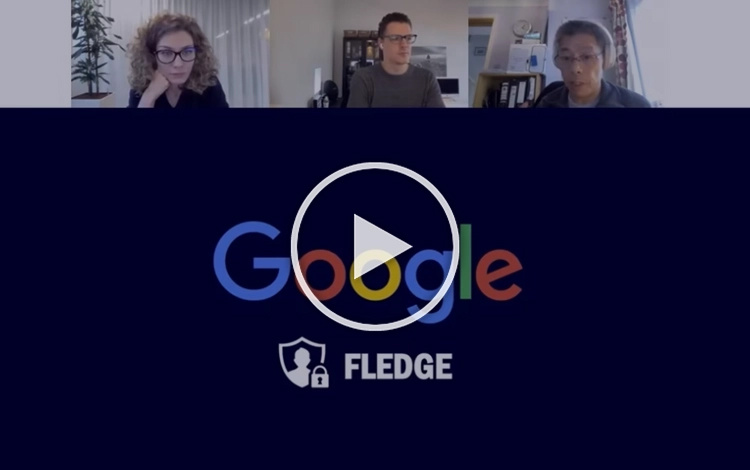Anonymous Personalization: How to Turn Website Visitors into Loyal Customers
by Melis Karabulut on 12.3.2025

![]() Written in partnership with Dotdigital.
Written in partnership with Dotdigital.
A visitor lands on your website, browses products, but leaves without a trace. No email, no login, just gone. Multiply that by thousands (or millions), and factor in the fact that customers visit a website between 3 to 8 times before making a purchase (at the very least). Now you see the problem: 90% of your visitors remain anonymous.
Even more challenging, around ⅓ of that 90% actively opt out of all tracking and marketing.

So, even with new-gen marketing tools and a strong customer acquisition strategy, reaching this black box audience is impossible; as this group doesn’t get registered in website analytics or your customer data platform due to data privacy regulations. That means 30% of potential new customers are unreachable.
But this doesn’t mean you’re powerless. In fact, you still have a huge opportunity to engage and convert a big part of these visitors without breaking privacy rules. BUT, your marketing team is probably already great at personalizing experiences for known customers, those who’ve logged in, subscribed or made a purchase. So now, let’s start tapping into the audience that deserves the same level of great personalization.
A website’s first impression is critical in digital acquisition marketing, either drawing visitors or pushing them away. Thus, using contextual data to create a welcoming experience can make a big difference for new visitors. So, how can you engage and convert anonymous visitors without access to traditional identifiers like email addresses, phone numbers, or vendor / 3rd party cookies?
Let’s find out in this article.
The anonymous gap: 90% of website visitors remain anonymous
Acquiring new customers is harder than ever. Privacy regulations are tightening, competition is fierce, ad costs are rising, and budgets are stretched thin. As a result, brands are finding it harder and harder to track and engage individual shoppers.
The website anonymity has multiple layers. I’d like to think of it like an iceberg - the small portion above the water represents known users that most personalization tactics focus on. But beneath the surface lies the massive opportunity of anonymous visitors, untouched and largely unaddressed.

Some users remain unidentified simply because they choose not to log in or use guest checkout options. Others actively block tracking mechanisms through browser settings and ad blockers, which makes traditional cookie-based tracking unreliable (ex: Apple’s iOS 14.5 update).
The highest level of anonymity includes website users who explicitly opt out of all tracking under data privacy laws like GDPR, which helps them remain completely invisible.
For marketers, this poses a tough challenge. The traditional suite of marketing tools still caters to a diminishing percentage of trackable users and leaves the vast majority of anonymous visitors with generic, impersonal marketing experiences. This is a major lost opportunity for user engagement and conversion.
Many real-time personalization tools can tailor website experiences based on anonymous browsing activity, but they rely on session cookies, which are increasingly unreliable for recognizing returning visitors, especially in browsers with strict tracking policies. While some visitors may still be identified, a significant portion goes unrecognized, limiting the effectiveness of these tools.
Additionally, many of these platforms focus heavily on capturing zero-party data through popups, surveys, and urgency tactics to collect email addresses as a persistent identifier. However, most anonymous visitors are not willing to engage this way, meaning brands miss out on optimizing experiences for a much larger audience that prefers to stay unidentified.
Your brand is influenced by the anonymous problem, too, whether you may like it or not. If you feel that your anonymous targeting strategy is not where you want it to be, think for a second. Ask yourself, do you rely solely on paid traffic to drive conversions? Are you maximizing engagement from repeat anonymous visitors? Is your customer acquisition strategy leveraging behavioral data effectively?
What happens when your brand starts identifying and engaging anonymous users
When your brand begins identifying and engaging anonymous visitors across many browsing sessions, you unlock a massive segment of potential customers that were previously overlooked. Instead of treating every visitor as a new user, advanced tracking and multi-key identity resolution allow you to recognize returning visitors more effectively, understand their browsing behavior, and tailor their experience. This means higher engagement, reduced bounce rates, and more meaningful interactions without forcing users to log in or provide personal details upfront.
Anonymous behavioral data such as product views, session duration, and navigation patterns, are more powerful than you may think. It can replace generic messaging with relevant content per user, provide contextual product recommendations, and well-timed offers that match their intent. This nurtures the hesitant buyer, provides higher conversion rates and better ad efficiency as you start converting more from paid awareness programs.
Moreover, harnessing anonymous users strengthens your retargeting and remarketing efforts across platforms like Facebook, TikTok, and Google Ads. When you can segment high-intent users like those who repeatedly view a product but haven’t purchased it, you can re-engage them with dynamic ads or personalized site experiences. Similarly, where an anonymous visitor starts to show interest in another product, you have the ability to alter the experience accordingly. This leads to a more effective acquisition funnel from top-of-funnel awareness to conversion.
So… why has the anonymous activation gap not been solved yet?
Despite years of innovation in MarTech, most of the technologies we’re using today fail to cater to anonymous visitors. Why? Because the majority of marketing tools were not designed for this problem and often left the real-time, behavioral activation problem to DMPs and “AdTech”. Let’s look at the reasons why.
Marketing automation tools (Email, SMS, Mobile): These platforms require explicit identifiers like email or phone number to activate personalized experiences. If a user is anonymous, these tools can’t help much.
Social walled gardens (Meta, TikTok, etc.): Social platforms encourage advertisers to upload first-party data (such as emails, explicit PII, IP addresses, and user agents) to enhance match rates. They also provide tracking pixels for building anonymous audiences, but these operate within the platform’s black box; marketers have little control over how the data is processed. Meta, for example, stores event data (including anonymous visitor behavior) for a maximum of 28 days, making it difficult to implement long-term retargeting strategies. TikTok operates similarly, relying on short-term tracking windows and heavily encouraging advertisers to share as much user data as possible for better targeting.
Google Ads & GA4 Integration: Google offers more retargeting opportunities through GA4’s integration with Google Ads, and allows marketers to build audiences based on website interactions. However, marketers’ trust in GA4 remains low due to inconsistencies between reported audience sizes. Concerns arise over whether Google is leveraging consent-level 1 data (analytics tracking) for retargeting purposes, which should legally require consent-level 3 (explicit marketing consent). Marketers, accordingly, face the challenge of ensuring compliance while relying on opaque data-sharing mechanisms.
Both Google and social ad platforms offer retargeting capabilities, but only if advertisers are willing to share vast amounts of first-party data. This growing reliance on deep data sharing raises concerns among legal teams, as marketers increasingly question whether they are fully compliant with evolving privacy regulations. Without full transparency into how these platforms handle data, marketers risk unknowingly targeting users who have not consented; potentially exposing their businesses to regulatory scrutiny.
Traditional CDPs (customer data platforms): Traditional CDPs struggle with anonymous website visitor tracking because storing and processing high-volume, real-time clickstream data is expensive, and require a mix of PII to use as the identifiers to build profiles from. Most CDPs are optimized for known customers and rely on structured relational databases that can’t efficiently process event-heavy anonymous traffic.
Real-time personalization tools: Many personalization tools rely on session-based tracking, which, while still using first-party cookies, faces increasing limitations due to browser restrictions like Safari’s ITP and Firefox’s ETP (while Google is ambiguous about phasing third-party cookies, marketers should still be prepared for it.). Unlike third-party cookies, session cookies remain functional but struggle with visitor recognition over time, especially if they aren't reinforced with server-side tracking. Additionally, many tools sync first-party cookies with third-party cookies to enhance tracking, but as third-party cookies phase out, this method becomes obsolete. Even now, where third-party cookies are still in use, reliance on client-side cookie syncing leads to data inconsistencies and fragmented customer journeys.
Based on these you may ask - does anonymous personalization have to suffer forever? The answer is no, if your brand starts adopting new personalized targeting strategies that work within these privacy-first constraints rather than against them. Instead of continuously increasing ad spend, your marketing team should focus on acquisition funnel marketing, optimize each stage of the funnel, and increase conversion rates from your hard-won existing traffic.
The reality of today is that 9 out of 10 brands are failing to engage anonymous visitors and leave massive revenue on the table. Brands that nail anonymous targeting - they significantly increase conversion rates from existing traffic and behavior patterns like browsing activity, geo-location, product interest or time spent on the key pages (... and decrease frustrations coming from forcing customers to log in too early).
Let’s discover how you can create a well-functioning anonymous targeting strategy, too.
If you’re ready to unlock the full potential of your anonymous visitors, join us for an exclusive event with our partner Dotdigital in London on March 20, 2025, where marketers will share strategies for driving conversions with anonymous data. 🇬🇧 📍
How to get started with anonymous web personalization
1 - Data collection without vendor or 3rd party cookies
What to do: Capture real-time behaviors like page views, geo-location, dwell time, and cart activity without relying on the expiration dates of cookies.
Why it works: Allows personalization without breaking privacy rules.
How to implement: Use identity resolution and server-side tracking to build and store anonymous user profiles.
The first step in addressing anonymous personalization is identifying anonymous visitors in a way that respects privacy while still enabling engagement. This means implementing anonymous website visitor tracking methods that go beyond traditional cookies; and doing this in real-time.
That’s why tools for personalizing anonymous visitors can track what people do on your site, like the categories they browse, price ranges they check out, what they search for, referring channels, and items they add to their carts; AND store that data (usually tied to an anonymous identifier) somewhere for activation, like a customer acquisition platform which is designed to keep all your customer data in one place.
Your customer acquisition platform will help you collect very valuable (and compliant) behavioral customer data without PII, such as:
- Device and browser information (desktop, mobile, tablet)
- Geolocation (approximate) based on IP
- Time spent on site and scroll depth
- Pages viewed and content interactions
- Referral source (where they came from)
- Search queries and navigation patterns
- Add-to-cart and cart abandonment behaviors
- Engagement with promotions or discounts
To start the data collection process, hence the anonymous website personalization altogether, your customer acquisition platform should be set up on your site or app to start collecting user behavior data and create unified profiles of both known and unknown visitors.
Once you have collected and unified this data, you should focus on integrating it into your customer acquisition funnel by categorizing anonymous web visitors into segments based on their behaviors. Here’s an example:
- High-intent shoppers who have repeatedly visited product pages but haven’t converted
- Cart abandoners who added items but left before purchasing
- Content engagers who frequently read/watch tagged content, guides, or FAQs
- New vs. returning visitor frequencies
- Referring channels (paid ads, social media, organic search, etc.)
|
Note: Since browser-based cookies are becoming less reliable, server-side tracking is a more effective approach to have control over the data and build persistent profiles that expand over time. This retains the insights you need for real-time activation such as geolocation, device type, and referral source to tailor the content being displayed. This allows you to recognize repeat visitors across sessions, track shopping cart activity even for guest checkouts, identify interest areas based on page visits and dwell time, understand intent signals and overall maintain a better level of continuity in the customer journey. |
2 - Providing relevant messaging per anonymous visitor
What to do: Use predictive AI to dynamically power audience segments and inform your creatives to adjust banners, recommendations, and content based on priority segments.
Why it works: Reduces bounce rates and keeps visitors engaged.
How to implement: Deploy personalized recommendations based on browsing history.
A key component here is leveraging predictive AI models. AI is particularly applicable in anonymous personalization strategies because the sheer volume and velocity of data is way beyond the behaviors from an email campaign, or your known visitors. Predictive AI therefore is essential for decisioning, and can help analyze behavior patterns and predict visitor intent without needing personal identifiers. By using predictive AI models trained on past behaviors, it can use that model to segment visitors based on interest, and judge their likelihood to convert within a specific time-frame through examining their browsing patterns, product interactions, and time spent on different pages.
AI is best able to make those real-time decisions and add/suppress specific audiences when required if it deems that the specific time-period for a conversion has passed, or a user starts to display different behaviors that don’t qualify for the same specific retargeting strategy anymore.
And since many returning visitors will not be recognized due to browser restrictions, you must ensure that personalization happens instantly within each session. This means dynamically adjusting content, promotions, and messaging based on current browsing activity AI-powered personalization can make this possible by adapting the experience in real time based on user behavior.
Once your unified profiles are in place, you can start personalizing the experience for anonymous visitors; everything from banners and categories to product recommendations and more.
For example, you can run different types of product recommendation campaigns and decide where they show up, whether it’s on every page, product and article pages, category pages, or even the cart page.
These all are based on user activities on your website and will be cookie-free recommendations for the user to receive personalized offers like recently viewed, location-based top sellers, checkout recommendations, etc.
3 - Make use of progressive consent tactics
What to do: Instead of relying on a single opt-in request at the start of a visitor’s journey, use a gradual, value-driven approach to encourage tracking consent over time. Introduce interactive tools that require light tracking, such as product quizzes, mood board creators, or savings calculators, to engage users without demanding immediate data collection.
Why it works: Many visitors initially opt out of tracking, but when they see a clear benefit, they are more likely to allow limited data collection. Unlike web push notifications, which have low opt-in rates unless they add direct value, progressive consent lets users choose tracking in exchange for enhanced experiences. Features like location-based personalization (ex: finding a nearby store) also give visitors a reason to enable tracking when relevant. This helps ease the user's hesitations to share their email or other personal details; as it offers a small and incremental engagement opportunity that helps build trust.
How to implement:
- Embed interactive gamification tools that encourage micro-conversions that move anonymous visitors closer to providing their data (ex: wheels, polls, surveys, quizzes, mood boards, calculators), which will also require limited tracking to function.
- Allow users to gradually enable consent by highlighting real-time benefits (ex: personalized recommendations, saved preferences).
- Provide location-based personalization to encourage tracking when needed (ex: showing nearby stores or service availability).
- A/B test different consent prompts throughout the user journey to see what drives the highest engagement
Final Words
Most brands struggle with anonymous visitors. Not because the audience isn’t valuable, but because traditional marketing tools weren’t built for them. A lot of marketers actually just see anonymous data as interesting dashboard metrics to draw conclusions from, as opposed to data you can actually capture and do amazing things with. So while it's partly the fact that most tools don't do it, it's also the case that marketers don't truly understand that they really leverage anonymous data further, or indeed don’t understand or know how to do it.
The reality is that over 90% of your website traffic is slipping through the cracks, and relying on just increasing your paid ads alone isn’t sustainable.
The good news? You don’t need personal identifiers to create a relevant and engaging experience. You can turn anonymous visitors into high-intent buyers without breaking privacy rules if you have the right tools at hand, and if you tap into real-time behavioral insights.
Now, it’s time to evaluate your strategy. How well is your brand engaging anonymous visitors today? Use the Anonymous Customer Acquisition Self-Evaluation Checklist below to find out where you stand and what steps you can take to improve.
ANONYMOUS CUSTOMER ACQUISITION SELF-EVALUATION CHECKLIST
Use this checklist to assess your brand’s readiness to address the anonymous problem:
You May Also Like
These Related Stories

What is Google's Protected Audience API and how will it impact programmatic advertising?

3 Digital Marketing Trends You Need to Watch Out For In 2025


.png?width=1414&height=2000&name=Black%20and%20White%20Lined%20Self%20Care%20Checklist%20(2).png)
.png?width=786&height=265&name=Relay42%20Demo%20Banner%20(1).png)